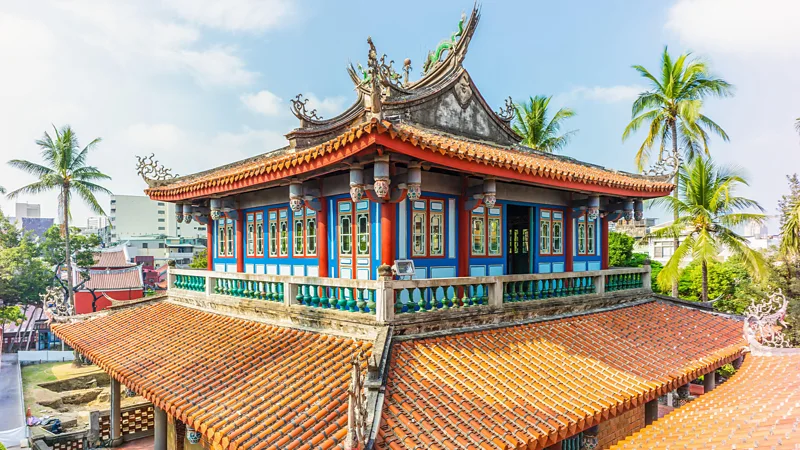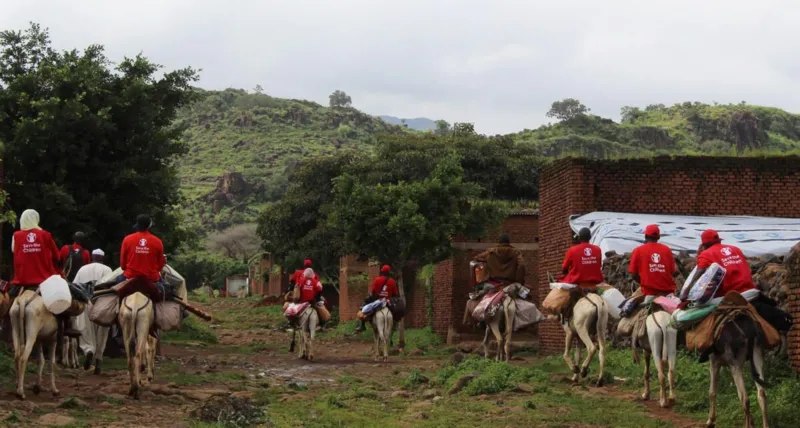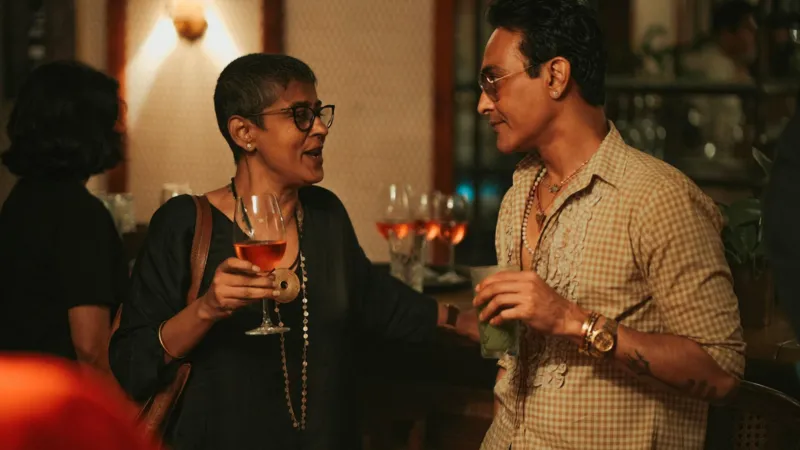Tainan: The 400-year-old cradle of Taiwanese culture
Known as "the birthplace of Taiwan", the island's oldest city is celebrating its quartercentennial by highlighting its multicultural past.

In 1624, a ragged fleet of ships owned by the Dutch East India Company arrived at a forested island off the coast of China. The Dutch merchants were looking for a foothold to trade with China's Ming dynasty, but had failed to seize the Portuguese enclave of Macau. The rugged, uncharted island to which they retreated was a place of last resort. They established a base on a long sandbank and built a fort, naming it Fort Zeelandia. They called the place where they settled Tayouan – or Taiwan.
The Dutch traded with the local Siraya people who spoke an Austronesian language more closely related to contemporary Malay, Tagalog and Māori than modern-day Mandarin. Some scholars argue that the word "Taiwan" itself has Indigenous roots – deriving from "tavo-an," meaning "meeting-place" in Siraya.
This year marks the 400th anniversary of the founding of both Fort Zeelandia and the city of Tainan that developed around the fort. And here in Taiwan's oldest city, celebrations are in full swing. The Tainan 400 celebrations, which began in January with the hosting of the Taiwan Lantern Festival and will continue into December, are dedicated to exploring Tainan's many stories, told in many languages. Under the slogan "Tainan, Where You Belong", a full year's worth of concerts, exhibitions and public celebrations are highlighting how the city has evolved as a melting pot of different cultures.
Today, the best way to experience Tainan is simply to wander its narrow streets and soak in its cultural diversity. Tainan is proud of its reputation as the birthplace of Taiwan and the cradle of Taiwanese culture, and it has managed to hold onto its roots more so than other Taiwanese cities. Compared to the capital Taipei or Tainan's nearest neighbour Kaohsiung – with their soaring skyscrapers that seem to reach into the future – Tainan feels like a place where the past and present collide. New high-rises compete for space with ancient monuments and tangled back alleys lined with centuries-old buildings. At weekends, the streets are noisy with the sounds of firecrackers and temple processions: the city has more Buddhist and Taoist temples than anywhere else in Taiwan.
Fort Zeelandia still stands in Tainan's Anping district. Tourists wander around the sprawling ruins where modern Taiwan was born, snapping photos of the old brick walls entwined with mammoth banyan roots. Next door, the Kaitai Tianhou temple is dedicated to the sea goddess Mazu. With a history dating back to 1668, the temple is the oldest shrine to the island's most popular deity. Inside, visitors continue the old-fashioned tradition of throwing pue, croissant-shaped blocks of wood, and asking the goddess for advice about their business dealings, family problems and love affairs. Outside, stalls selling shrimp crackers, fried sweet potato balls and Tainan's local delicacy kuann-tshâ-pang or "coffin bread" (fried bread stuffed with seafood sauce) speak to the city's reputation as Taiwan's street food capital. And on the far side of the road, elderly residents sit on plastic chairs in the shade chatting in Taiwanese, a dialect derived from the original Hokkien spoken by settlers who arrived from Fujian in China that has largely disappeared elsewhere on the island in favour of Mandarin.
Before the Dutch arrived, Taiwan's population was largely made up of culturally and linguistically diverse Indigenous groups. When the Dutch established Taiwan's first school in modern-day Tainan in 1636, classes were taught in Siraya, and in 1661, the missionary Daniel Gravius published his translation of The Gospel of Matthew into Siraya as well. One year later, Ming dynasty rebel Koxinga seized Fort Zeelandia and expelled the Dutch, setting in motion waves of migration from China. This first wave of Chinese settlers was mainly made up of Hokkien-speakers from Fujian. But two decades after Koxinga, when Taiwan passed into the hands of the Qing dynasty and Tainan became the capital of the new Taiwan Prefecture, other groups arrived, including a substantial Hakka-speaking community. The island remained under Qing control for two centuries until it was ceded to the Japanese in 1895. The Japanese stayed until the end of World War Two, and Japanese became the island's lingua franca. Today in Taiwan, there are some elderly people who are still more comfortable speaking Japanese than Mandarin or Taiwanese.
Throughout this long, complex history, Indigenous languages were increasingly pushed to the margins. Some, including Siraya, nearly disappeared entirely. But there were further threats to Taiwan's cultural and linguistic diversity on the horizon. In 1949, after their defeat in the Chinese civil war, Chiang Kai-shek's Nationalists retreated to Taiwan. To consolidate their rule, the Nationalists imposed martial law and proclaimed Mandarin as the national language, even though hardly anyone in Taiwan spoke it. Nevertheless, for nearly four decades, the Nationalists did their best to transform the culturally and linguistically diverse people of Taiwan into a Chinese-identifying, Mandarin-speaking monoculture.
But the Nationalists' monocultural vision of Taiwan was always a fiction, and in the decades since the ending of martial law in 1987, the country has been rediscovering its multicultural and multi-linguistic identity. In Tainan and elsewhere in southern Taiwan, these Mandarin-only policies were policed with less fervour and resistance was more firmly entrenched. As a result, Taiwanese remains an integral part of the city's identity today. And as a sign of the city's ongoing commitment to diversity of languages and cultures, the official website for Tainan 400 greets visitors in Taiwanese, Siraya and Hakka.
To understand how Tainan is rediscovering this cultural diversity, I visited the Confucius temple in Tainan's city centre to talk to the head of the temple's cultural foundation, Dr Tsio̍h Bo̍k-bîn. As we sat in the airy hall with its burgundy walls and swooping eaves, Tsio̍h explained how Taiwanese culture was built from successive waves of colonialism. Tsio̍h noted that even the temple itself, which appears archetypally Chinese, is a hybrid. Constructed using building techniques borrowed from the Dutch, it was rebuilt and restored by the Japanese. "The Confucius temple is a composite, a tapestry," he said. It is a complete record of Taiwan's colonial history."
In addition to his work at the temple, Tsio̍h is committed to the revival of the Taiwanese language. "I think we need a strong and clear expression of being Taiwanese," he said. "Language is a token of self-expression. Taiwanese society is heading toward a vision of a linguistically equal society. Not just Taiwanese, but also Hakka and aboriginal languages. We want our society to be able to see these languages as equals."
But there are challenges, too. During Taiwan's decades of martial law, Mandarin was the standard language on the island. And while Taiwanese is now being taught again in schools across Taiwan, few young people speak it fluently. One person working to reverse this trend is YouTuber and Anping native Chiu Ka-éng, who goes by the name of Ayo. Ayo's YouTube channel, Tâi-lâm muē-á kàu lí kóng Tâi-gí (A Tainan Girl Teaches You Taiwanese), is popular for its high-energy delivery, retro visuals and linguistic research.
"There are over 7,000 languages in the world, but they are gradually disappearing," Ayo told me over Zoom. "I wonder if my mother tongue will vanish in my lifetime. The connection between language and place is very close. Language has a specific feeling, and if you change the language, the feeling disappears." For Ayo, this makes the Tainan 400 celebrations an opportunity "to imagine together how this place came to be". It is a chance to ask, "what kind of future we want for the next 100 or 400 years".
Alongside Taiwanese, another language revival is underway in Tainan: Siraya. Spearheading the revival are Uma Talavan, an Indigenous Siraya, and her husband Edgar Macapli. Three decades ago, the couple came across Gravius's translation of Matthew's Gospel. Since then, they have dedicated themselves to the revival of Siraya as a living language. When I met the couple in a coffee shop in the suburb of Xinhua, they brought along a pile of newly published Siraya textbooks and we discussed how, after more than a century of silence, Siraya is now being spoken again and taught in more than 20 schools across Tainan.
This revival is also a reminder of the deeper history of Taiwan, one that reaches back thousands of years. "The buildings may be 400 years old," Talavan said. "But this land is not 400 years old. For our people, our history, our life… I always say it's 400-plus."
I asked Talavan what her hopes are for the language's revival. "In the future," she said, "we want Siraya to be used from kindergarten through to university." I told her I have started to learn the language, out of curiosity. Talavan laughed. "Maybe you can become a Siraya teacher too," she said.
To spend time in Tainan at 400 (or "400-plus") is to realise that, despite outsiders' best efforts, Taiwan remains a complex tapestry of languages and cultures. And this year's celebrations are a reminder that identity doesn't need to be simple, or single, and that there is strength and richness in complexity.
As Tsio̍h told me before I climbed on my bike to cycle home from the Confucius temple: "We Taiwanese are not that pure. We're a hybrid society. We should be proud of that and start telling people this history and these stories of hybridity. Then maybe we can find peace with ourselves."
-bbc






